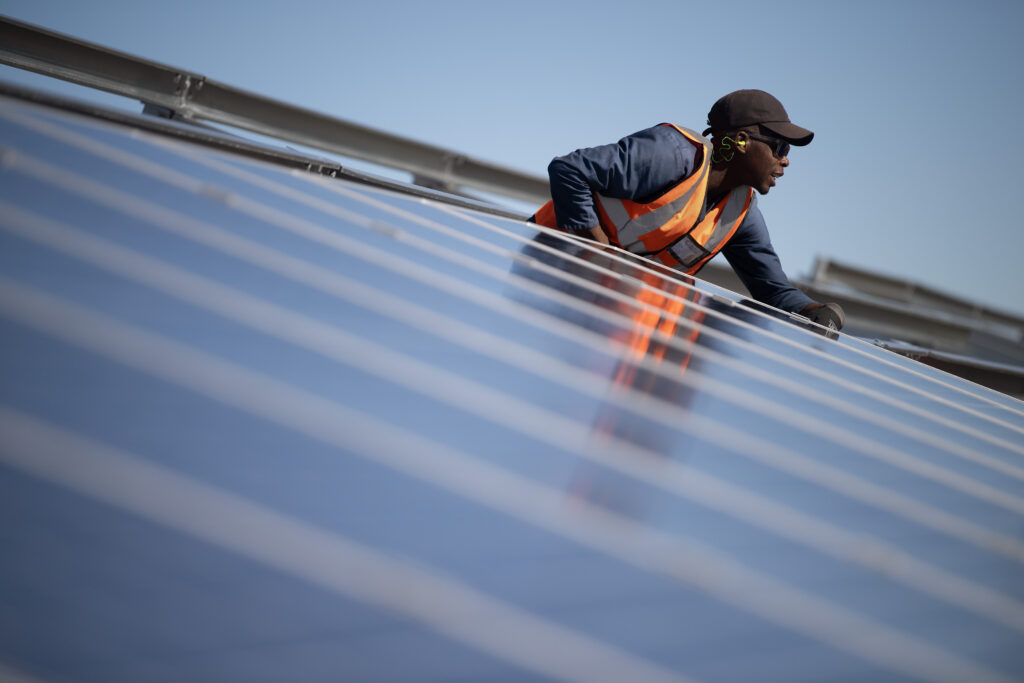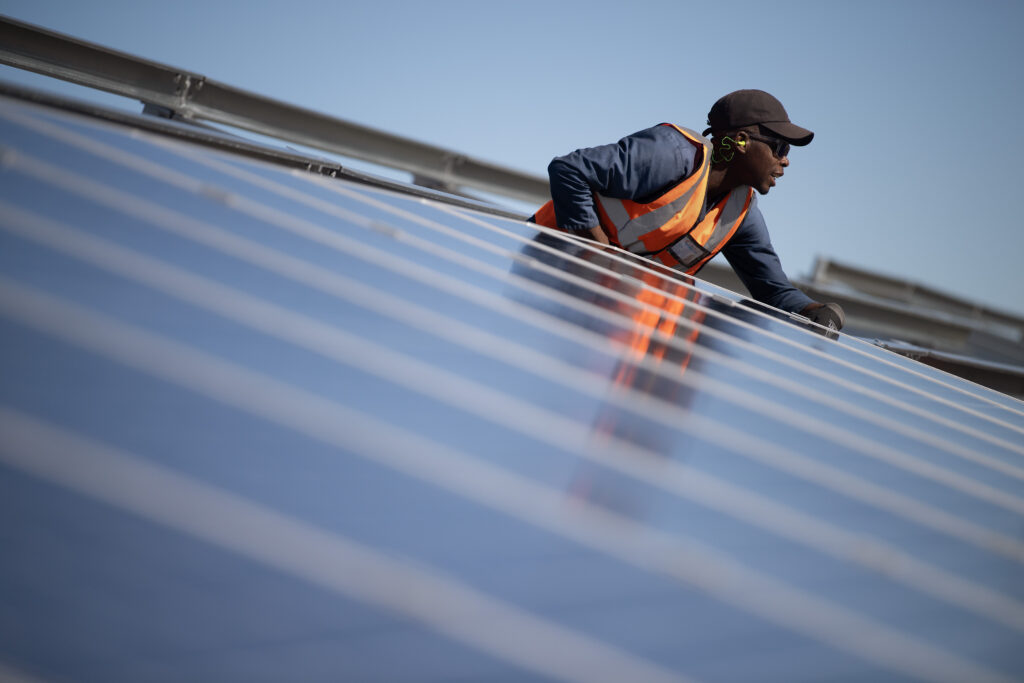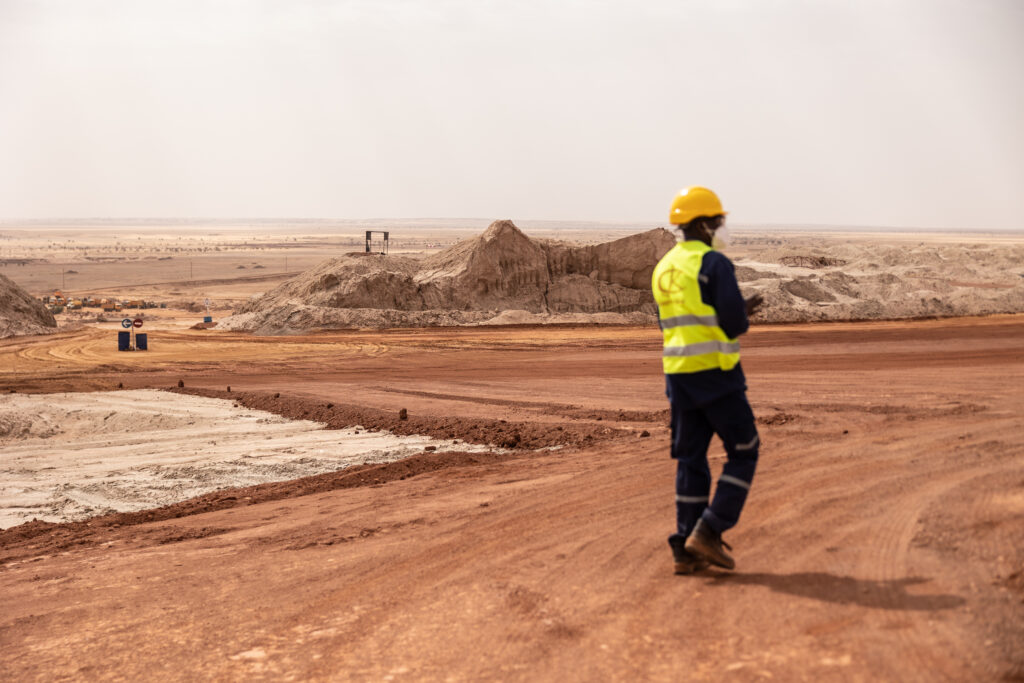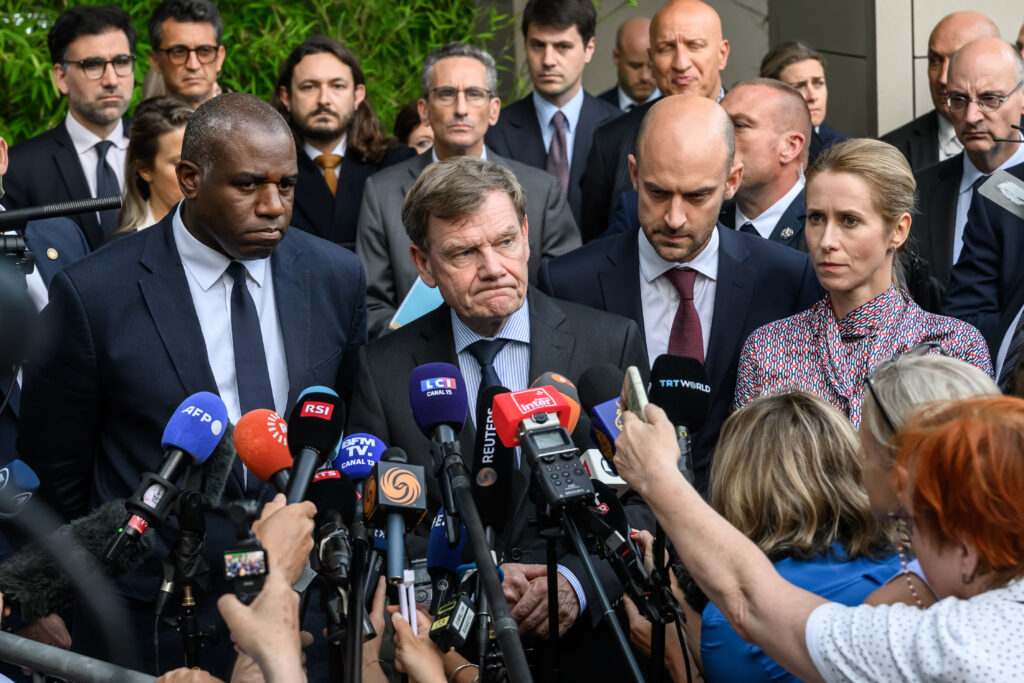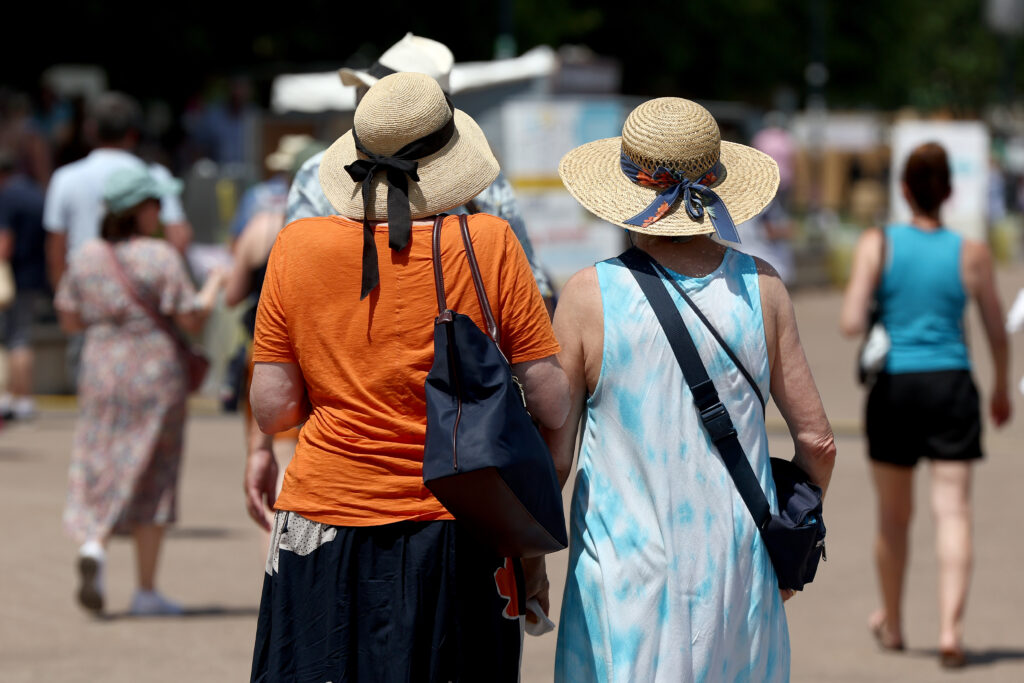World Bank and IMF climate snub ‘worrying’, says COP29 presidencyFri, 20 Jun 2025 19:38:12 GMT
The hosts of the most recent UN climate talks are worried international lenders are retreating from their commitments to help boost funding for developing countries’ response to global warming.Major development banks have agreed to boost climate spending and are seen as crucial in the effort to dramatically increase finance to help poorer countries build resilience …
World Bank and IMF climate snub ‘worrying’, says COP29 presidency
The hosts of the most recent UN climate talks are worried international lenders are retreating from their commitments to help boost funding for developing countries’ response to global warming.Major development banks have agreed to boost climate spending and are seen as crucial in the effort to dramatically increase finance to help poorer countries build resilience to impacts and invest in renewable energy.But anxiety has grown as the Trump administration has slashed foreign aid and discouraged US-based development lenders such as the World Bank and the International Monetary Fund from focussing on climate finance.Developing nations, excluding China, will need an estimated $1.3 trillion a year by 2035 in financial assistance to transition to renewable energy and climate-proof their economies from increasing weather extremes.Nowhere near this amount has been committed.At last year’s UN COP29 summit in Azerbaijan, rich nations agreed to increase climate finance to $300 billion a year by 2035, an amount decried as woefully inadequate. Azerbaijan and Brazil, which is hosting this year’s COP30 conference, have launched an initiative to reduce the shortfall, with the expectation of “significant” contributions from international lenders.But so far only two — the African Development Bank and the Inter-American Development Bank — have responded to a call to engage the initiative with ideas, said COP29 president Mukhtar Babayev.”We call on their shareholders to urgently help us to address these concerns,” he told climate negotiators at a high-level summit in the German city of Bonn this week.”We fear that a complex and volatile global environment is distracting” many of those expected to play a big role in bridging the climate finance gap, he added.- A ‘worrisome trend’ -His team travelled to Washington in April for the IMF and World Bank’s spring meetings hoping to find the same enthusiasm for climate lending they had encountered a year earlier.But instead they found institutions “very much reluctant now to talk about climate at all”, said Azerbaijan’s top climate negotiator Yalchin Rafiyev.This was a “worrisome trend”, he said, given expectations these lenders would extend the finance needed in the absence of other sources.”They’re very much needed,” he said.The World Bank is directing 45 percent of its total lending to climate, as part of an action plan in place until June 2026, with the public portion of that spilt 50/50 between emissions reductions and building resilience. The United States, the World Bank’s biggest shareholder, has pushed in a different direction. On the sidelines of the April spring meetings, US Treasury Secretary Scott Bessent urged the bank to focus on “dependable technologies” rather than “distortionary climate finance targets.”This could mean investing in gas and other fossil fuel-based energy production, he said.Under the Paris Agreement, wealthy developed countries — those most responsible for global warming to date — are obliged to pay climate finance to poorer nations.Other countries, most notably China, make voluntary contributions.- Money matters -Finance is a source of long-running tensions at UN climate negotiations.Donors have consistently failed to deliver on past finance pledges, and have committed well below what experts agree developing nations need to cope with the climate crisis.The issue flared up again this week in Bonn, with nations at odds over whether to debate financial commitments from rich countries during the formal meetings.European nations have also pared back their foreign aid spending in recent months, raising fears that budgets for climate finance could also face a haircut.At COP29, multilateral development banks (MDBs) led by the World Bank Group estimated they could provide $120 billion annually in climate financing to low and middle income countries, and mobilise another $65 billion from the private sector by 2030. Their estimate for high income countries was $50 billion, with another $65 billion mobilised from the private sector. Rob Moore, of policy think tank E3G, said these lenders are the largest providers of international public finance to developing countries. “Whilst they are facing difficult political headwinds in some quarters, they would be doing both themselves and their clients a disservice by disengaging on climate change,” he said.The World Bank in particular has done “a huge amount of work” to align its lending with global climate goals. “If they choose to step back this would be at their own detriment, and other banks like the regionally based MDBs would likely play a bigger role in shaping the economy of the future,” he said. The World Bank declined to comment on the record.
Iran rejects nuclear talks with US before Israeli ‘aggression’ stops
Iran said Friday it would not resume nuclear negotiations with the United States until Israel halts its attacks, as Israel’s military chief warned the week-old war will be “prolonged”.A series of blasts were heard in Tehran on Friday as Iran’s Fars news agency said air defences had been activated, as Israel kept up its bombardment and Iran launched missiles at its arch enemy.”We must be ready for a prolonged campaign,” Israeli military chief Eyal Zamir told Israelis in a video statement, eight days after his country launched a massive wave of strikes it said were aimed at stopping Iran from developing nuclear weapons — an ambition Tehran has denied.”The campaign is not over. Although we have made significant achievements, difficult days still lie ahead,” he said.As US President Donald Trump mulls the prospect of entering the war between the two foes, top diplomats from Britain, France and Germany met with their Iranian counterpart Abbas Araghchi in Geneva.Referring to nuclear negotiations with Washington that had been derailed by the war, Araghchi said after the meeting that “Iran is ready to consider diplomacy once again and once the aggression is stopped”.Tehran did “support the continuation of discussion with” the European countries and was willing “to meet again in the near future”, Araghchi told reporters.French Foreign Minister Jean-Noel Barrot said “we invited the Iranian minister to consider negotiations with all sides, including the United States, without awaiting the cessation of strikes, which we also hope for”.Barrot said there “can be no definitive solution through military means to the Iran nuclear problem” and warned that it was “dangerous to want to impose a regime change” in Iran, after Israeli Prime Minister Benjamin Netanyahu did not rule out killing supreme leader Ayatollah Ali Khamenei.On the streets of Tehran, many shops were closed and normally busting markets largely abandoned on Friday, an AFP journalist reported.”I’m not afraid of the war, I stay open but business is really bad,” said a vendor at the Tajrish market who declined to give his name for security reasons.Nearby, police set up a checkpoint while workers repaired a road damaged in a recent Israeli strike.- 450 missiles – Since Israel launched its offensive on June 13, targeting nuclear and military sites but also hitting residential areas, Iran has responded with barrages which Israeli authorities say have killed at least 25 people.A hospital in the Israeli port of Haifa reported 19 injured, including one person in serious condition, after the latest Iranian salvo.More than 450 missiles have been fired at the country so far, along with about 400 drones, according to Israel’s National Public Diplomacy Directorate. Iran said on Sunday that Israeli strikes had killed at least 224 people, including military commanders, nuclear scientists and civilians. It has not updated the toll since.A US-based NGO, the Human Rights Activists News Agency, provided a toll on Friday based on sources and media reports, saying at least 657 people have been killed in Iran, including 263 civilians.Israel’s military said it struck missile launchers in southwestern Iran after overnight air raids on dozens of targets including a nuclear research centre.In Israel, sirens sounded in the afternoon after missiles were launched from Iran for the second time on Friday. Iran’s Revolutionary Guards said they had targeted military sites and air force bases.Trump said on Thursday he will decide “within the next two weeks” whether to involve the United States in the fighting.A US Navy official said Friday that an aircraft carrier will be moved closer to the Middle East next week, making it the third in or near the region.- ‘Madness’ -“This is a perilous moment, and it is hugely important that we don’t see regional escalation of this conflict,” said Britain’s Foreign Secretary David Lammy, who earlier stated “Iran can never develop or acquire a nuclear weapon”.Western governments suspect Iran of seeking a nuclear weapons capability.The International Atomic Energy Agency said that while Iran is the only country without nuclear weapons to enrich uranium to 60 percent, there was no evidence it had all the components to make a functioning nuclear warhead.”So, saying how long it would take for them, it would be pure speculation because we do not know whether there was somebody… secretly pursuing these activities,” the agency’s chief Rafael Grossi told CNN.”We haven’t seen that and we have to say it.”In an interview with German publication Bild, Israel’s top diplomat Gideon Saar said he did not “particularly” believe in diplomacy with Iran.”All diplomatic efforts so far have failed,” said Saar, whose country had supported Trump’s 2018 decision to abandon a previous nuclear agreement between Iran and world powers.Turkish President Recep Tayyip Erdogan warned the escalating confrontation is quickly reaching “the point of no return”, saying “this madness must end as soon as possible”.UN chief Antonio Guterres meanwhile pleaded with all sides to “give peace a chance”.Any US involvement in Israel’s campaign would be expected to involve the bombing of an underground uranium enrichment facility in Fordo, using powerful bunker-busting bombs that no other country possesses.Switzerland announced it was temporarily closing its embassy in Tehran, adding that it would continue to fulfil its role representing US interests in Iran.burs-ser/ami/kir
Sahel juntas pile pressure on foreign mining firmsFri, 20 Jun 2025 19:08:44 GMT
Army strongmen who have seized power in coups across Africa’s Sahel region since 2020 have ramped up pressure on foreign mining companies in the name of greater control over their countries’ riches.Niger’s nationalisation of the local branch of French uranium giant Orano on Thursday is the latest such measure by the junta and its allies …
Sahel juntas pile pressure on foreign mining firmsFri, 20 Jun 2025 19:08:44 GMT Read More »
Europe powers urge Iran to keep up diplomacy despite Israeli strikes
European powers on Friday urged Iran to revive diplomatic efforts with the United States to find a solution in the standoff over its nuclear programme, but Tehran warned it could only consider diplomacy once Israel halted its bombardment of the Islamic republic.British, French, German and EU top diplomats held talks in Geneva with Iranian Foreign Minister Abbas Araghchi, giving diplomacy a chance one week after Israel started its bombardment.”The good result today is that we leave the room with the impression that the Iranian side is ready to further discuss all the important questions,” said German Foreign Minister Johann Wadephul in a statement alongside his European counterparts.”It is of great importance that the United States takes part in these negotiations and the solution,” he added.The statements read by all four top diplomats in their native languages after the talks expressed hope of further progress but did not make any mention of a breakthrough.Araghchi, making his first trip outside Iran since the bombardment began, said Tehran was ready to “consider diplomacy” again only once Israel’s “aggression is stopped”.”In this regard I made it crystal clear that Iran’s defence capabilities are not negotiable,” he said.”We support the continuation of discussion… and express our readiness to meet again in the near future,” he said.- ‘Urgently find a solution’ -British Foreign Secretary David Lammy said: “We are keen to continue ongoing discussions and negotiations with Iran, and we urge Iran to continue their talks with the United States.””This is a perilous moment, and it is hugely important that we don’t see regional escalation of this conflict,” he added.French Foreign Minister Jean-Noel Barrot said there “can be no definitive solution through military means to the Iran nuclear problem. Military operations can delay it but they cannot eliminate it”.After Israeli Prime Minister Benjamin Netanyahu did not rule out killing supreme leader Ayatollah Ali Khamenei, Barrot also warned: “It is illusory and dangerous to want to impose a regime change from the outside. It is up to the people to decide their own destiny.””We invited the Iranian minister to consider negotiations with all sides, including the United States, without awaiting the cessation of strikes, which we also hope for,” he said.EU foreign policy chief Kaja Kallas added: “Today the regional escalation benefits no-one. We must keep the discussions open.”Iran’s state-run IRNA news agency said earlier the Iranian delegation “emphasised that Iran has not left the negotiating table”.Israel began its campaign on Friday last week saying the operation was aimed at halting Tehran from obtaining an atomic bomb, an ambition Iran denies having. Iran has in response launched strikes on Israel.The European ministers “expressed their view that all sides should refrain from taking steps which lead to further escalation in the region, and urgently find a negotiated solution to ensure that Iran never obtains or acquires a nuclear weapon,” they said in a joint written statement.bur-dt-ah-sjw/jj
Gill launches India captaincy reign in style with hundred against England
Shubman Gill marked his first innings as India captain with a sparkling hundred after fellow young gun Yashasvi Jaiswal also scored a fine century against England at Headingley on Friday.India — sent into bat by England captain Ben Stokes — were in the commanding position of 359-3 at close of play on the first day of this five-Test series. Gill was 127 not out after sharing a stand of 129 for the third wicket with opener Jaiswal, dismissed for 101 shortly after tea.The aggressive Rishabh Pant was 65 not out, including an extraordinary swiped six off Chris Woakes in the last over of the day as he piled on the agony for England during an unbroken stand of 138 with his new skipper. “It was very, very good and we all did well today,” Jaiswal told Sky Sports after the close as he hailed Gill’s innings by saying: “He played amazingly. He was very composed and calm all the time.”This was a chastening start to the new World Test Championship cycle for England following South Africa’s victory over Australia in last week’s final at Lord’s.”It was a tough day,” said England bowling coach Tim Southee. “We will come back tomorrow and try to make some inroads.”The former New Zealand paceman added: “The openers did well early on, particularly Rahul….There were two great knocks, Jaiswal and Pant are class players.”Concerns had been expressed before the series about how India would cope in England without Rohit Sharma, Gill’s predecessor as captain, and Virat Kohli after the two star batsmen retired from Test duty within days of each other last month.Yet such is the depth of talent in cricket-obsessed India, quality replacements were always likely to be available. Stokes’ decision to field may have been influenced by the fact the last six Tests at Headingley have been won by the team batting second.But England, without retired greats James Anderson and Stuart Broad and missing injured express quicks Jofra Archer and Mark Wood, rarely threatened on a good batting pitch under increasingly sunny skies.Woakes was given the new ball after returning in place of the injured Gus Atkinson but his 19 wicketless overs cost 89 runs, with all-rounder Stokes’ 2-43 in 13 making him the pick of England’s attack. – Sublime stroke-play -Jaiswal and opening partner KL Rahul got India off to a fine start in their quest for just a fourth Test series win in England after triumphs in 1971, 1986 and 2007.England, however, enjoyed a double strike shortly before lunch as 91-0 was transformed into 92-2.Rahul (42) carelessly edged a wide ball from Brydon Carse to Joe Root at first slip before Sai Sudharsan fell for a duck on Test debut when caught down the legside by diving wicketkeeper Jamie Smith off Stokes.But India’s third-wicket duo regained the initiative with sublime stroke-play.Stokes brought on Shoaib Bashir to add variety but the off-spinner’s first ball was cuffed for four by left-hander Jaiswal, who went to 99 with two superb boundaries off Carse.A quick single took an elated Jaiswal to a 144-ball hundred, including 16 fours, as he completed his fifth century in 20 Tests and third against England.It also meant the 23-year-old had scored hundreds on his Test debut, his first Test in Australia and first in England.Jaiswal, however, was out when bowled by a fine Stokes delivery from around the wicket that angled in and held its line.Pant, however, thumped Stokes back over his head for four off just his second ball.The 25-year-old Gill completed his century with a superb cover-driven four off fast bowler Josh Tongue, his 14th boundary in 140 balls faced.As he admired the shot, Gill ripped off his helmet in celebration of his sixth hundred in 33 Tests and third against England.Gill later pulled Tongue over Bashir’s head at fine leg for six and was just shy of his highest Test score of 128 at stumps. Before play both teams and the match officials observed a minute’s silence in memory of the victims of an Air India plane crash in Ahmedabad that killed all but one of 242 people on board.
La France au-delà de 35°C pour la première vague de chaleur de l’été
Avec 16 départements en alerte orange, la France a connu vendredi des températures supérieures à 35°C sous l’effet de la première vague de chaleur de l’été, qui culminera samedi sur l’ensemble du pays où une soixantaine de départements sont placés en vigilance jaune.Météo-France a relevé vendredi vers 17h00 des températures atteignant 39,3°C à Vailhan dans l’Hérault, 37,5°C à Saintes (Charente-Maritime), 36,7°C à Narbonne et plus de 35°C à Toulouse, Nantes et Rennes, selon des valeurs provisoires.À Ussel en Corrèze, où les températures avoisinaient encore 29°C en début de soirée, un enfant d’un peu plus d’un an, laissé dans une voiture stationnée au soleil, a dû être hospitalisé dans un état grave, selon les pompiers et le parquet, qui a ouvert une enquête. La victime, souffrant de déshydratation, a été héliportée en “urgence absolue” à la mi-journée. La Corrèze était placée vendredi en vigilance jaune, au sein d’une large façade ouest du pays qui a enregistré des valeurs parfois supérieures de dix à douze degrés par rapport aux normales de saison.Quatorze départements situés sur une large zone allant de la Manche à la Charente-Maritime et du Morbihan à l’Indre-et-Loire avaient, eux, été placés en vigilance orange canicule à compter de vendredi midi, de même que le Rhône et l’Isère dans le Centre-Est.Une soixantaine d’autres départements sont concernés par une vigilance jaune canicule pour la journée de samedi, la plus chaude de la semaine, et six pour les orages. Enfin, deux sont vendredi en vigilance orange pour les incendies (Aude et Bouches-du-Rhône) vendredi, trois samedi (Vaucluse, Deux-Sèvres et Maine-et-Loire).En Gironde, où plusieurs dizaines de milliers de visiteurs sont attendus jusqu’à dimanche pour le festival Bordeaux fête le vin, les participants s’agglutinaient par grappes à l’ombre des arbres et des parasols vendredi après-midi.- “Eviter de se cramer” -Pascal Spinat, informaticien de 47 ans vivant à Pau, s’est muni d’un chapeau de paille “à larges bords pour éviter de se cramer, tout simplement”.Participant à l’événement pour “la cinquième ou sixième fois”, cet habitué concède que “c’est la première fois qu’il fait aussi chaud” mais s’attend à ce que cela devienne la norme: “Il y a de grandes chances d’avoir une canicule” tous les ans, anticipe-t-il.À Toulouse, les piétons fuyaient la chaleur, notamment sur la place du Capitole, où de grandes ombrières permettent selon la mairie de réduire la chaleur de 5°C en moyenne.EDF a anticipé pour sa part de possibles baisses de production sur le site de la centrale nucléaire de Bugey (Ain), en raison des températures élevées du Rhône, qui refroidit l’installation.Et plusieurs départements ont émis des alertes concernant la pollution à l’ozone samedi, notamment en Île-de-France, Provence-Alpes-Côte-d’Azur et Occitanie. À Lorient (Morbihan), l’agglomération a décidé de la gratuité de ses transports en commun.Cette chaleur est provoquée par le blocage d’un anticyclone sur la France: une dépression d’altitude sur l’Atlantique fait remonter des masses d’air chaud présentes sur la péninsule ibérique.Un pic de chaleur concernera samedi, jour de la fête de la musique, une large moitié ouest avec 35 à 38°C, localement 39°C du Val de Loire à l’Occitanie. Les températures élevées s’étendront au nord de la Loire jusqu’au Bassin parisien et vers l’Est, mais aussi de l’autre côté de la Manche en Angleterre. – Épisode “assez bref” -“On atteindra probablement 39 degrés localement avec sans doute quelques records”, a déclaré à l’AFP Jérôme Lecou, prévisioniste de Météo-France, qui s’attend à un “épisode assez bref”.”Samedi soir, un petit vent d’ouest va s’établir”, note-t-il, “donc on va commencer à avoir un léger rafraîchissement (…) avec une sortie de la vigilance dès dimanche” et une chaleur cantonnée lundi “plutôt aux régions méridionales”.C’est la 50e vague de chaleur recensée par l’établissement public depuis 1947, et l’une des plus précoces.”Vingt-cinq ont été observés entre 1947 et 2010″ et “25 déjà entre 2011 et 2025”, ce qui “montre bien l’accélération” de la fréquence sur fond de réchauffement climatique, relève Loriane Baté, climatologue de Météo-France.La France métropolitaine s’est déjà réchauffée d’au moins 1,7°C par rapport à l’ère pré-industrielle, avant la combustion massive du charbon, du pétrole et du gaz, et les pouvoirs publics se préparent à un réchauffement de 4°C d’ici la fin du siècle.Le réchauffement climatique rend les vagues de chaleur plus précoces et tardives, plus fréquentes, plus longues et plus intenses.burs-bl-tsq-jed/gf/cbn
La France au-delà de 35°C pour la première vague de chaleur de l’été
Avec 16 départements en alerte orange, la France a connu vendredi des températures supérieures à 35°C sous l’effet de la première vague de chaleur de l’été, qui culminera samedi sur l’ensemble du pays où une soixantaine de départements sont placés en vigilance jaune.Météo-France a relevé vendredi vers 17h00 des températures atteignant 39,3°C à Vailhan dans l’Hérault, 37,5°C à Saintes (Charente-Maritime), 36,7°C à Narbonne et plus de 35°C à Toulouse, Nantes et Rennes, selon des valeurs provisoires.À Ussel en Corrèze, où les températures avoisinaient encore 29°C en début de soirée, un enfant d’un peu plus d’un an, laissé dans une voiture stationnée au soleil, a dû être hospitalisé dans un état grave, selon les pompiers et le parquet, qui a ouvert une enquête. La victime, souffrant de déshydratation, a été héliportée en “urgence absolue” à la mi-journée. La Corrèze était placée vendredi en vigilance jaune, au sein d’une large façade ouest du pays qui a enregistré des valeurs parfois supérieures de dix à douze degrés par rapport aux normales de saison.Quatorze départements situés sur une large zone allant de la Manche à la Charente-Maritime et du Morbihan à l’Indre-et-Loire avaient, eux, été placés en vigilance orange canicule à compter de vendredi midi, de même que le Rhône et l’Isère dans le Centre-Est.Une soixantaine d’autres départements sont concernés par une vigilance jaune canicule pour la journée de samedi, la plus chaude de la semaine, et six pour les orages. Enfin, deux sont vendredi en vigilance orange pour les incendies (Aude et Bouches-du-Rhône) vendredi, trois samedi (Vaucluse, Deux-Sèvres et Maine-et-Loire).En Gironde, où plusieurs dizaines de milliers de visiteurs sont attendus jusqu’à dimanche pour le festival Bordeaux fête le vin, les participants s’agglutinaient par grappes à l’ombre des arbres et des parasols vendredi après-midi.- “Eviter de se cramer” -Pascal Spinat, informaticien de 47 ans vivant à Pau, s’est muni d’un chapeau de paille “à larges bords pour éviter de se cramer, tout simplement”.Participant à l’événement pour “la cinquième ou sixième fois”, cet habitué concède que “c’est la première fois qu’il fait aussi chaud” mais s’attend à ce que cela devienne la norme: “Il y a de grandes chances d’avoir une canicule” tous les ans, anticipe-t-il.À Toulouse, les piétons fuyaient la chaleur, notamment sur la place du Capitole, où de grandes ombrières permettent selon la mairie de réduire la chaleur de 5°C en moyenne.EDF a anticipé pour sa part de possibles baisses de production sur le site de la centrale nucléaire de Bugey (Ain), en raison des températures élevées du Rhône, qui refroidit l’installation.Et plusieurs départements ont émis des alertes concernant la pollution à l’ozone samedi, notamment en Île-de-France, Provence-Alpes-Côte-d’Azur et Occitanie. À Lorient (Morbihan), l’agglomération a décidé de la gratuité de ses transports en commun.Cette chaleur est provoquée par le blocage d’un anticyclone sur la France: une dépression d’altitude sur l’Atlantique fait remonter des masses d’air chaud présentes sur la péninsule ibérique.Un pic de chaleur concernera samedi, jour de la fête de la musique, une large moitié ouest avec 35 à 38°C, localement 39°C du Val de Loire à l’Occitanie. Les températures élevées s’étendront au nord de la Loire jusqu’au Bassin parisien et vers l’Est, mais aussi de l’autre côté de la Manche en Angleterre. – Épisode “assez bref” -“On atteindra probablement 39 degrés localement avec sans doute quelques records”, a déclaré à l’AFP Jérôme Lecou, prévisioniste de Météo-France, qui s’attend à un “épisode assez bref”.”Samedi soir, un petit vent d’ouest va s’établir”, note-t-il, “donc on va commencer à avoir un léger rafraîchissement (…) avec une sortie de la vigilance dès dimanche” et une chaleur cantonnée lundi “plutôt aux régions méridionales”.C’est la 50e vague de chaleur recensée par l’établissement public depuis 1947, et l’une des plus précoces.”Vingt-cinq ont été observés entre 1947 et 2010″ et “25 déjà entre 2011 et 2025”, ce qui “montre bien l’accélération” de la fréquence sur fond de réchauffement climatique, relève Loriane Baté, climatologue de Météo-France.La France métropolitaine s’est déjà réchauffée d’au moins 1,7°C par rapport à l’ère pré-industrielle, avant la combustion massive du charbon, du pétrole et du gaz, et les pouvoirs publics se préparent à un réchauffement de 4°C d’ici la fin du siècle.Le réchauffement climatique rend les vagues de chaleur plus précoces et tardives, plus fréquentes, plus longues et plus intenses.burs-bl-tsq-jed/gf/cbn

